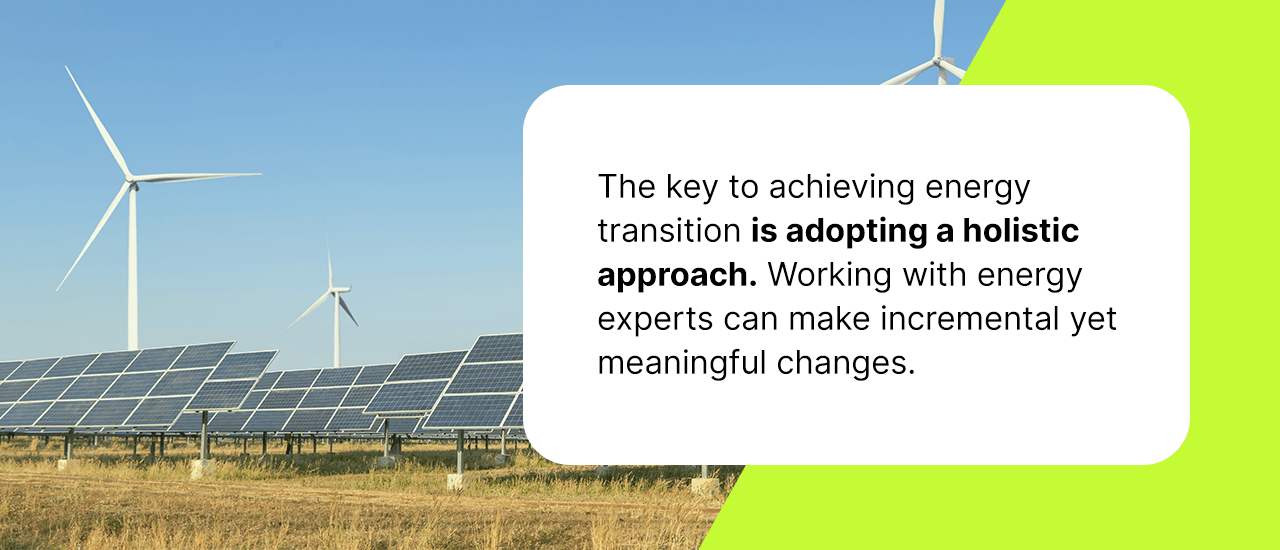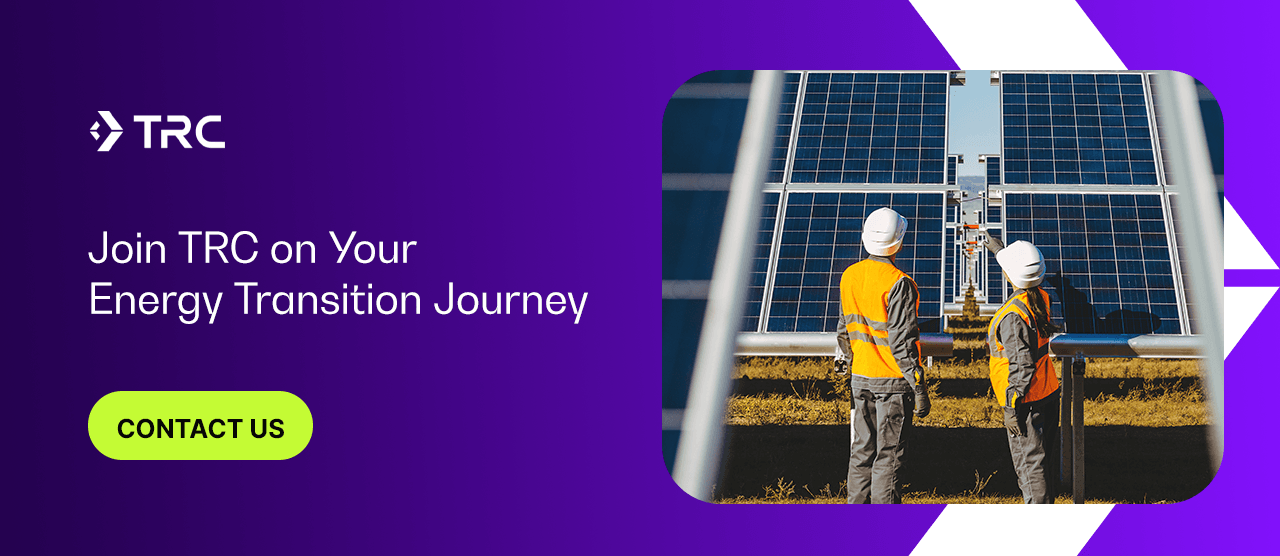Energy transition is the goal of eliminating reliance on fossil fuels for power generation. The escalating climate emergency and urgent energy crisis indicate a breakdown of legacy systems, ushering in a new and more sustainable energy era. The energy industry has made significant changes, yet fossil fuels still dominate energy generation.
The energy transition is ongoing, requiring real-time strategic updates and community involvement. With 67% of Americans agreeing that the country should prioritize developing alternative energy sources, businesses must adjust their roadmaps for maximum sustainability impact. The journey begins with understanding the destination, and the more organizations know about the transition to clean energy, the better they can align sustainability strategies with maintaining profitability and meeting consumer demands.
Understanding Energy Transition
Energy transition means moving away from fossil fuels and toward renewable energy sources. Electricity generation is responsible for about one-third of U.S. carbon emissions, so the process is a massive undertaking. It requires short- and long-term strategies across the global energy sector. The principal goal is to achieve complete carbon neutrality by 2050, avoiding greenhouse gas emissions. In the short term, the aim is to halve emissions by 2030.
We have already made significant progress in transitioning to a clean energy future. Renewable energy sources have become more economically viable. With almost 90% of consumers believing organizations should do more to reduce their carbon impact, societal pressure has played a considerable role. However, the transition is challenging in many respects. Businesses must change their paradigms and operating systems while maintaining an edge in competitive markets.
Although energy transition is a fluid process, three main strategies have emerged that businesses can use to achieve internal and broader emissions and efficiency goals:
- Reduce greenhouse gas emissions: Promoting the use of sustainable fuels over fossil fuels.
- Use renewable energy: Encouraging replacing fossil fuel-generated energy sources with renewable sources such as solar or wind power.
- Improve energy efficiency: Integrating energy-efficient technology and protocols for businesses and energy efficiency.
Energy Transition and Climate Change
The relationship between energy transition and climate change includes the following elements:
- Mitigating the effects of climate change: Renewable energy technologies produce little to no carbon emissions and could provide 90% of the reductions in CO2 emissions.
- Improving air quality: The burning of fossil fuels releases more than CO2. It also releases harmful pollutants and particulate matter into the atmosphere, which can cause various health problems for the population. Shifting to clean energy sources improves human and animal health.
- Reducing dependence on fossil fuels: Many countries still depend on fossil fuels as their primary source of energy generation. The energy transition will reduce this dependence by investing in renewable energy infrastructure.
- Conserving natural resources: Fossil fuel extraction has a devastating impact, including water pollution and habitat destruction. The energy transition reduces the need for resource-intensive extractions and the accompanying environmental damage.
- Supporting sustainable development: The energy transition empowers communities to manage their power. Renewable energy sources are often decentralized from the grid, providing clean energy in remote areas. The transition also promotes job creation and economic growth in the green technology and renewable energy sectors.
Left unchecked, climate change and traditional energy create a vicious cycle. Fossil fuel-based energy contributes to climate change, putting additional strain on the energy infrastructure. Natural disasters are becoming more frequent due to climate change, and a lack of grid resilience in the face of weather events like floods, fires and storms causes widespread blackouts.
 The Pillars of Energy Transition
The Pillars of Energy Transition
The energy transition may seem daunting for businesses balancing sustainability and profitability. Understanding the actionable steps they can take provides a roadmap for incremental change. Large-scale energy transition requires more than infrastructural change — a complete shift at every level is necessary to meet emissions and sustainability goals.
The three pillars of energy transition for businesses include:
1. Understand Renewable Energy Basics
The first step to transitioning from fossil fuels to renewable energy sources is gathering information on the different types of renewables. Many emerging technologies exist in renewable energy generation, like offshore wind and solar farms. The most common renewable energy resources include:
- Wind: As wind flows over the blades of a turbine, it creates mechanical power by turning the blades. A built-in drive shaft turns an electric generator to produce electricity.
- Solar: When light hits photovoltaic cells, it knocks electrons loose from the semiconductor material, generating electricity.
- Hydropower: Like wind power, water flows through hydroelectric dams, generating mechanical energy that spins a turbine connected to an electric generator.
- Geothermal: This form of energy generation leverages underground heat. Pipes and wells pump hot water from underground reservoirs. The water boils over into steam as it reaches the surface, rotating steam turbines. These turbines are connected to generators that produce electricity.
- Biomass: Biomass consists of organic plants and matter from living organisms. It’s collected and burned in a boiler, producing steam, which rotates turbine blades connected to generators. Biomass can also be converted into other liquids and gases and used as fuel for electricity generation.
- Nuclear: Nuclear energy is not technically renewable but is still considered clean energy. Using nuclear power plants to generate energy is a contentious issue. Many people are against it due to problems like radioactive waste, which is harmful to the environment.
Weather fluctuations and climate variability are among the most significant challenges when transitioning to renewable energy sources. For example, solar panels can only produce electricity when exposed to sunlight. The energy demand is inconsistent, and people use electricity at different times.
Therefore, energy storage solutions like distributed energy resources are crucial in the transition process. Lithium-ion battery storage is a standard storage solution for solar energy. These massive batteries store energy when there is more supply than demand.
As demand increases or the renewable source becomes inconsistent, users rely on this stored energy, preventing it from going to waste. These solutions allow renewable energy resources to produce power even during minimal demand. Various types of storage exist, from flow batteries to pumped hydroelectricity.
2. Make Energy Efficiency Improvements
As long as we rely on fossil fuels for the bulk of our electricity, any energy wastage is counterintuitive for the energy transition. Many businesses may be unable to transition entirely to renewables in the short term, but they can make incremental energy-efficiency improvements, including:
- Invest in energy-saving equipment: Every business has different needs and equipment requirements. Depending on the industry, companies can upgrade their equipment to minimize wastage, like using energy-efficient lighting and insulation.
- Power down: On average, 30% of the energy used in commercial buildings is wasted. A simple change like powering down at the end of the day makes an entire business more energy efficient.
- Set goals: Energy efficiency is a team effort. Businesses can set monthly efficiency goals and involve their teams in achieving them, such as not exceeding a set amount of electricity usage.
- Integrate renewable energy sources: Installing solar panels is the first step for many businesses. The changes can be small but can be implemented more as they become economically viable.
- Optimize supply chain operations: Energy transition requires considerable cooperation. Businesses can partner with suppliers with the same sustainability commitment to optimize logistics and implement sustainable practices across the supply chain.
- Collaborate with experts: Many businesses need help to maximize sustainability and profitability. Working with a consulting firm specializing in renewable energy transition can provide valuable insights and energy efficiency ideas.
3. Comply With Government Energy Policies
The U.S. government has instituted several policies to govern and promote the use of renewable energy sources in businesses, including:
- The Energy Policy Act: Passed in 2005, the Energy Policy Act covers almost all aspects of energy production in the U.S. It provides tax incentives and other benefits for renewable energy production. It also offers additional loan payments for technologies that generate power without greenhouse gases.
- The Energy Independence and Security Act: This legislation aims to move the country toward greater energy independence and security, increasing the production of clean, renewable fuels. It identifies and improves energy efficiency in products, buildings and research.
- The Inflation Reduction Act: This climate legislation is the most significant in U.S. history. It offers various incentives and funding to accelerate the transition to clean energy.
Technology is one of our most valuable assets in energy transition, and the impact of digital transformation on the energy sector is profound. Over 70% of the electricity grid in the U.S. is over 25 years old, necessitating upgrades to meet current power and sustainability demands. Integrating cutting-edge technologies can improve grid reliability, enhance energy efficiency and reduce emissions.
Smart grid technologies are coming to the fore, using advanced technology solutions like data analytics to boost grid resiliency and reduce emissions. Artificial intelligence (AI) plays a pivotal role in energy transition, collecting and analyzing massive amounts of data to highlight discrepancies in the clean energy transition. Integrating significant qualities of renewable energy generation is another area where technology shines. Digital technology and machine learning can forecast and match supply and demand, reducing emissions, cutting costs and improving grid resilience.
Grid decentralization is increasing across the globe as more communities transition to renewables and proactively manage their consumption. As uncertainty over energy prices and grid resilience grows, technology like smart meters provides comprehensive energy consumption data, reducing electricity costs and limiting wastage. In short, technology is the most accessible roadmap to complete energy transition.
Overcoming Challenges in Energy Transition
Energy transition represents a seismic shift in mindsets and operational processes — challenges are expected. Although clean energy sources reached a record of 40.6% of total U.S. electricity in 2022, we have a long way to go. Some common energy transition challenges include:
- Renewable energy accessibility: For businesses to adopt renewable energy sources, they must be competitive against traditional alternatives. Recent technological advancements have made it possible to transition without impacting profitability.
- Grid stability and resilience: Energy transition requires a stable and resilient grid to avoid negative impacts on business operations. Energy storage solutions play a massive role in establishing grid stability against the variability of renewable energy sources.
- Economic impact: Many communities across the U.S. rely on the financial impact of traditional energy production. Some worry that widespread energy transition will lead to economic instability. However, continued research and increasing infrastructure are making the transition more viable.
- Social acceptance: Despite the global shift toward prioritizing renewable energy solutions, only 31% of Americans say they are ready to phase out fossil fuels entirely. An overwhelming majority support their continued use alongside renewables. Much of their hesitancy stems from concerns over grid resilience and economic impact, and a widespread shift in mindsets is the only way to achieve total energy transition.
The key to achieving energy transition is adopting a holistic approach. Working with energy experts can make incremental yet meaningful changes. A clean and sustainable energy system is only possible when taking complete advantage of technological innovations and industry expertise. For businesses, agility, peace of mind and fortitude are critical ingredients in making the shift. As compliance goalposts and industry trends evolve, end-to-end energy transition solutions will keep organizations agile in a rapidly changing landscape.
How Businesses Play a Role in a Greener Future
Businesses are powerful allies in the global energy transition. They must play several roles to make an impact while achieving their objectives. If organizations can balance satisfying consumer needs, remaining profitable and reducing their carbon footprint, they’ve won half the battle. The other half goes beyond the numbers, placing sustainability at the core of their mission and vision for the future.
When organizations emphasize energy transition, consumers follow their example. Energy-efficient practices, principles and products filter through the population, alleviating concerns about a future built on renewable energy.
Charting the Path Forward
Although we have already made significant positive changes in the quest for energy transition, we still have many challenges to overcome to reach the established 2030 and 2050 goals. A melting pot of policies, market trends, technology and consumer concerns means navigating the path with care. Approaches must be agile and intentional to navigate this yet unchartered territory.
Despite the challenges and concerns, businesses must take proactive steps toward energy transition, from outsourcing energy audits to educating employees. As the world focuses on sustainability, new technologies will continue to emerge, streamlining the path to a complete transition to renewable energy sources. The first steps may be minor changes, but their value will combine over time as we usher in a new era of power generation.
Join TRC on Your Energy Transition Journey
A successful energy transition means considerable changes in many business operations. In line with net-zero goals, the energy landscape is constantly evolving, and your organization must keep up with these rapid changes to meet its energy transition objectives. Partnering with experts who understand these industry fluctuations will help you navigate the various challenges associated with energy transition.
As a trusted partner to the utility industry for over 50 years, we have our finger on the pulse of renewable energy trends and technologies. TRC’s tested practitioners can help you make informed decisions about your power systems. We will guide you through complex energy issues and help you maintain profitable operations throughout your transition.
Contact us for more information and start your sustainability journey today.

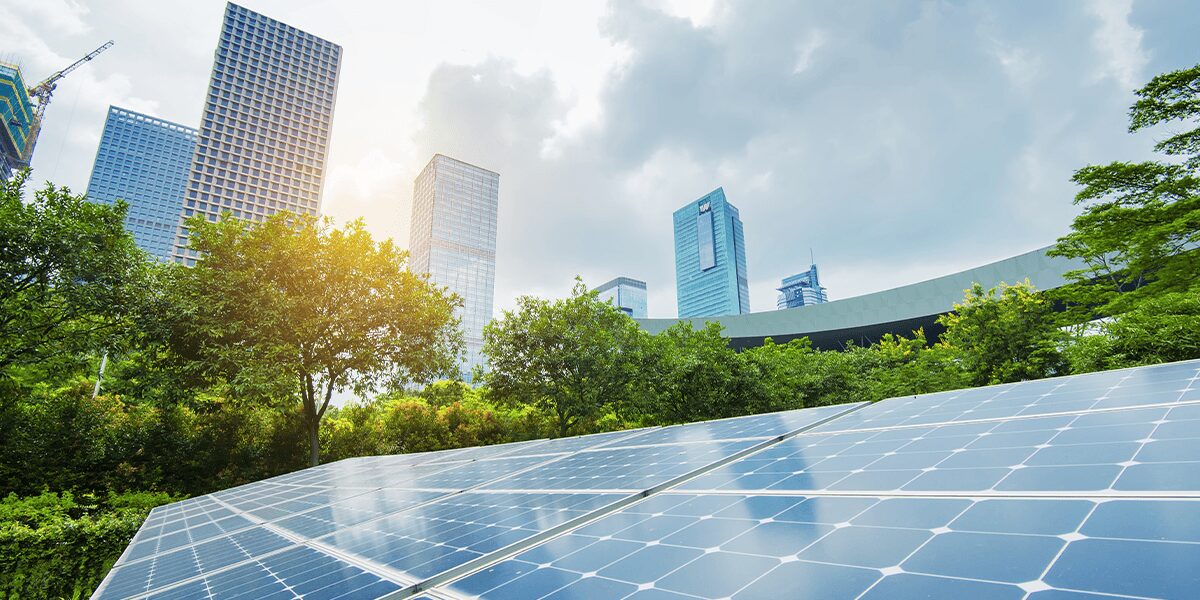

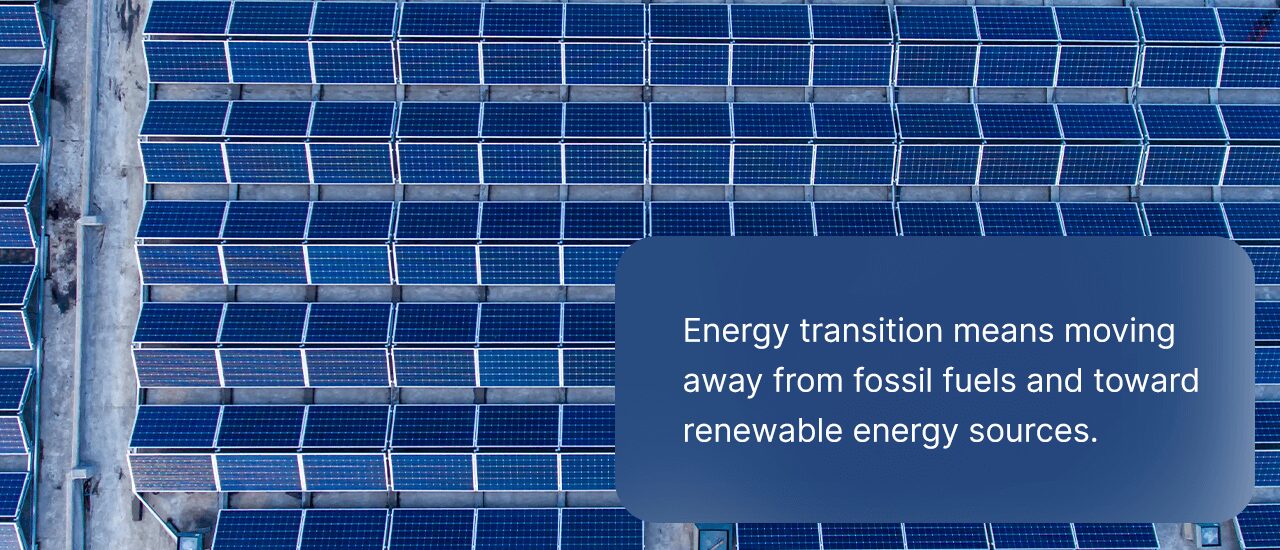
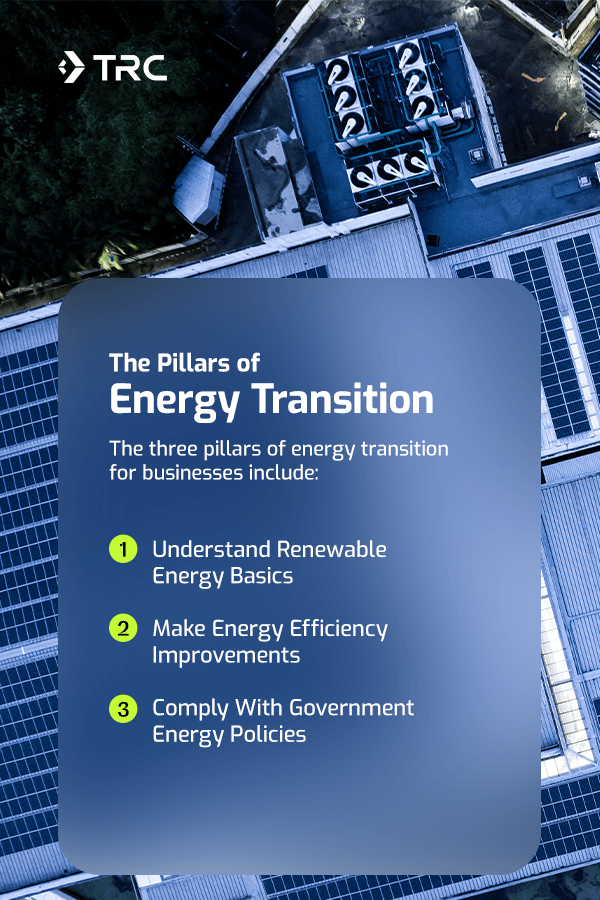 The Pillars of Energy Transition
The Pillars of Energy Transition